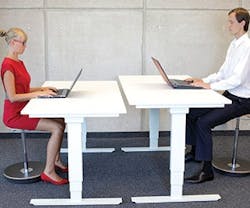From back pain and eye strain to hand, arm and shoulder injuries, bad ergonomic design spells disaster for productivity. Discomfort is distracting, but a pain-free employee can fully focus on work – and that’s good for business. Make sure their desks don’t interfere by choosing one with good ergonomic design.
Ergonomic Basics
A sound ergonomic environment in the office depends largely on chair selection, but desks play an important role. An ideal setup produces “as many 90-degree angles as possible” for the user’s body, explains Daniel Freeberg, Senior Sales Associate for The Human Solution, an office furniture vendor. Because hips, knees and elbows should all produce right angles for optimum comfort, both the chair and the desk must be adjusted to the correct height for the user and be the right proximity to each other. “For your neck, you should be looking at the top third of your computer screen,” Freeberg adds.
But sitting more comfortably is only half the battle. You can go further to support worker health by specifying sit-stand desks, height-adjustable desks that allow users to switch between sitting and standing throughout the day.
“Many studies show the health benefits of moving around over the course of the day,” explains Mitch Bakker, a furniture designer for IDa Design and frequent collaborator with furniture vendor Gunlocke. “Standing for a portion of the time is part of an overall approach to working ergonomically.”
How to Pick the Right Desk
When you’re weighing your options for new furnishings, don’t neglect these three areas.
Optimization: “Having furniture that allows for proper adjustments does not mean that the adjustments are set correctly,” Bakker notes. “Independent studies have demonstrated that the majority of office workers sit in products that can provide sound ergonomics, but they are not adjusted properly, ultimately having an adverse effect on the user. Understanding the relationship between the user, their size and their workload against the settings is critical to lowering or eliminating risk. Providing adjustability can be more harmful to a user when they are not given instructions on how to tailor the furnishings.”
Adjustment mechanism: Desks that can be adjusted by the user instead of the facilities department are ideal because they allow each person to choose when to switch modes, notes Jennifer Wammack, a designer for IDa Design.
“Within user-controlled options, electric mechanisms seem to be edging out other options like a turn crank or a pneumatic lift,” adds Wammack. “Electric mechanisms also have added features such as presets that an occupant can program for their ideal ergonomic needs. Presets are one way to address the potential for injuries stemming from improper adjustments.”
Movable accessories: If a sit-stand desk isn’t a good fit for your budget right now, consider raising only a portion of the surface, either with adjustable accessories or a fixed-height desk with a height-adjustable tray.
“You want to have space for your mouse, keyboard and possibly a tablet,” explains Freeberg. “Ergonomically, laptops are terrible for you because they’re at a set height that is generally too low and the keyboard is usually attached to the monitor, which is too far. You want it on your lap where you’re typing. Look into a tablet stand or laptop stand.”
A monitor arm that allows for 3-5 inches of height adjustment will guard against eye strain, adds Bakker.
Janelle Penny [email protected] is Senior Editor of BUILDINGS.
About the Author
Janelle Penny
Editor-in-Chief at BUILDINGS
Janelle Penny has been with BUILDINGS since 2010. She is a two-time FOLIO: Eddie award winner who aims to deliver practical, actionable content for building owners and facilities professionals.

